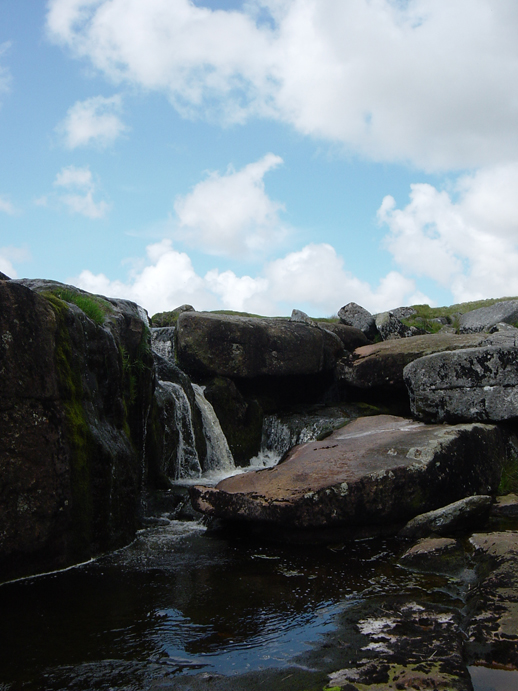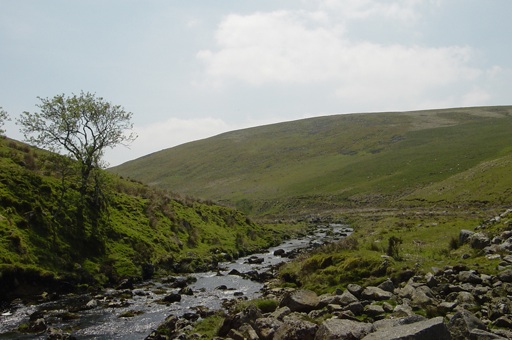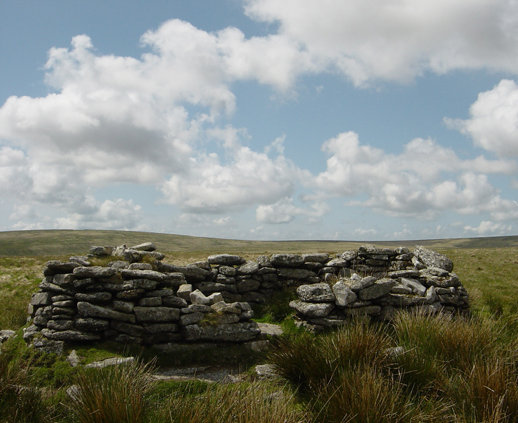Words & pictures from West Country correspondent, Mr. Alex Smith
Two walks, three rivers, two waterfalls.
The first waterfall fell towards the end of a walk that started on the Erme and crossed over Stall Moor to the Yealm. These two rivers are born almost within sight of one another. On a one kilometre grid map you’d go up two squares and right one to get from Yealm Head to Erme Head. And on your way over Langcombe Hill you’d look west down the valley that hosts Langcombe Brook on its way to join the Plym. It’s a fertile place for rivers, this small square of Dartmoor. Erme Head, then, is to the north of Langcombe Hill, close by Erme Pits on the Abbot’s Way. Yealm Head is to the south of the hill and therefore shorter, closer to the sea already. When the Erme turns south at Stingers Hill it flows to the Erme Plains and the two then run in parallel, divided only by Stall Moor and, later, by the steep-sided hill that is Stalldown Barrow. The Erme passes to the east of the barrow and down into Ivybridge and Ermington and Holbeton to enter the English Channel at Bigbury Bay. The Yealm flows to its western flank and tracks a very different path to the sea through Cornwood and Yealmpton and Newton and Noss.
We started from New Waste on the path by the works and, only shortly thereafter, spent a half hour loitering around the settlements just to the north of the track. It was a little difficult at first to distinguish huts from clitter on the untidy hillside but we were soon aided by the traces of the ancient routes leading down and through the site from the barrow above and, obligingly, the huts became more defined the further we went around the southern flank of the hill. We had a short stop to do justice to the views over the Erme to Piles Hill and Sharp Tor and the stone-walled field systems sitting in the valley between our viewpoint and the Hall Plantation. There were buzzards overhead and skylarks closer to and the sun was up and warming the ground. So we sat and we talked and the birds became a little braver and the skylarks came down to the ground nearby.
On again to views over Piles Copse and an exploration of the beehive tinners hut at Downing’s House. A couple of photos and then lunch at the weir with its take-off that pumps water over and around Stalldown and up to the treatment works of our departure. An interesting find this, a shining stainless colander tube submerged below the peat-brown water with long streams of weed to its edges. You could imagine the underground path of the water from the weir to a rusty iron stop cock standing waist high on a pebbly concrete mound. Underground from there, I suppose, to the little pumping house with the photo-voltaic cell on its corrugated roof and then off to the works on a route hard to fathom. All strangely fitting for this part of the moors once heavy with mining and only a spit away from Harford. There were thousands of people here once with their blowing houses and their wood and stone shacks, altering the course of the river many times on the long open bends that characterise this part of the Erme.
We walked through the long-healed grassed-over scars of the mines and on to where a stream joins the Erme from the west. A short trip up to the head of this stream and it was across the open moors to an impressive walled settlement, one of the best I’ve seen. With views afforded by the drop-away of the Yealm and Ranny Brook valleys to its west and south, it commands the local area and gives quick and easy access to the river and its waterfall at Yealm Steps.
In the grand scheme of things, it is not a great waterfall. With the lack of rain at the time of this walk at the end of May it was less impressive still. But it tumbled through boulders and fell into small pools that might have tempted the wild swimmer on a warmer day. A stream, really, at this place overlooking Dendles Waste, it is a Dartmoor river in its juvenile form. Not yet out of short trousers it is fordable for most of its length here wherever there is a well placed rock to break the jump into a hop and a step.
The second waterfall was reached at the halfway point of our trip the following week. A walk above the East Dart from Postbridge, following the line of a disused leat for much of the way, and an approach to the waterfall along the eastern bank of the river on its downhill reaches. More water here but levels still very low and the air full of mayflies, their long forked tails giving their flight an uphill bias. The fingerling trout in their pools intercepted the stalled and mopped up those carried down the river from upstream pancake landings, torpedoing up from their busy-water ambush points to sometimes completely clear the surface.
Lunch, again, by falls and a route through Sandy Hole Pass and up to Statts House with views to Sittaford Tor which is much at its best from this position. The line of sight to Sittaford from high on Winney’s Down starts with the obvious path that leads from our feet down to the marshy bottom, and rises again, back up to the tor on a straight track of an angle that only occasionally lets you see the peak when you get to walk its rise. That marsh in the dip, by the way, becomes a stream that feeds the nascent North Teign River and meets the Whitehorse Leat that snakes around the back of Sittaford to our next destination, the Grey Wethers (restored).
The Grey Wethers are too perfect and, often, too busy. Two complete stone circles with a gap between, they are conveniently placed, plum on the track that will take us back to Postbridge. It is quite a distance yet but the arrow-straight path of the map (not quite so straight on the ground) will speed us to Postbridge and an ice cold drink from the Post Office stores.
We took a seat to watch the German coachloads pose for photos on the clapper bridge and buy expensive marmalade from the selection in the cabinet by the door. It’s the summers that help him through the grim winters, the owner tells us as he waves one lot off to Widecombe in the Moor just as another D plated coach pulls into the visitor centre car park next door. A young walking couple order cones from the hatch in the Post Office wall and a cyclist necks an energy drink sitting by his bike on the grassy island where the fuel pumps, long gone, once sat. This isn’t the Dartmoor of our winters, when, on catching sight of a lone walker on a distant horizon, one of us will turn to the other and say “It’s like bloody Piccadilly Circus up here today”. But it’s still better than being anywhere else.


